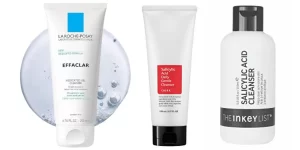
What does Niacinamide do for your skin?
This powerful skincare ingredient offers numerous benefits, like softening the appearance of wrinkles, evening out your skin tone, and improving your skin texture.
Really If you’re not already using niacinamide you should be.
But first…
What is niacinamide?
Niacinamide, also known as Vitamin B3 and nicotinamide, is a water-soluble vitamin and an excellent skincare ingredient.

It is a powerful antioxidant that can help reduce inflammation, improve skin barrier function, reduce hyperpigmentation, treat acne, and minimize the appearance of wrinkles.
Niacinamide can be found in many products, such as serums, moisturizers, toners, and spot treatments.
4 Benefits of using niacinamide in your skincare routine
So what can niacinamide do for your skin?
Here are five ways niacinamide can help improve your skin:
1. Boost hydration
Niacinamide helps to bind water to the skin and restore its natural protective barrier by increasing the production of ceramides, which helps to keep moisture in the skin.
Niacinamide also helps to fortify your skin’s natural barrier, reducing trans-epidermal water loss (TEWL) and preventing environmental toxins from entering, thus improving its barrier function.
2. Reduce inflammation
Niacinamide has powerful anti-inflammatory properties which can help soothe your skin and reduce redness and irritation associated with acne, eczema, and other common skin conditions.
Not only does it help calm the skin, but it also helps to regulate oil production which reduces breakouts and inflammation.
3. Treat acne
Niacinamide is an effective treatment for acne due to its anti-inflammatory properties; it helps reduce redness and inflammation, while also decreasing sebum production and balancing the skin’s pH levels.
Niacinamide has been shown to reduce the appearance of acne, both in the form of breakouts and post-acne scarring, by decreasing the amount of sebum (oil) that your skin produces.
Which helps prevent clogged pores and blemishes.
4. Fade hyperpigmentation
Niacinamide helps to fade hyperpigmentation, age spots, and other forms of skin discoloration by inhibiting melanin production in the skin, resulting in a brighter more even skin tone over time.
With all that being said should you use niacinamide in your skincare routine?
Yes, niacinamide can work well in your skincare routine. It can help reduce the appearance of pores, reduce redness and improve your skin texture.
It can also help improve the overall health of your skin, including reducing inflammation and promoting healthier skin cells.
However, if you have sensitive skin, rosacea, or eczema, proceed with caution or avoid using niacinamide, as it can irritate.
Additionally, if you are allergic to nicotinic acid, you should avoid using niacinamide.
Okay so you’ve decided to incorporate it into your routine but how do you use niacinamide?

How to use niacinamide in your skincare routine (step by step)
Step #1
Cleanse
You always want to start your routine by cleansing with a gentle facial cleanser.
This will help remove any dirt, oil, and makeup from your skin, preparing it for the rest of your routine.
Follow with a toner, if desired.
Step #2
Toner (optional)
After cleansing, use a toner to balance your skin’s pH levels and help it prepare for the absorption of niacinamide.
Step #3
Niacinamide
Depending on your skin type, you can use niacinamide as a serum, cream, or lotion.
This step is if you’re using a niacinamide serum. If you’re using a moisturizer or lotion then use it after the toner or after using other serums.
If you have oily skin look for a lightweight serum or lotion.
Take a small amount and gently massage it into your skin.
Step #4
Moisturizer
Using the right moisturizer for your skin type is essential in keeping your skin hydrated and healthy.
If you have oily skin, use a lightweight, oil-free moisturizer that absorbs quickly without leaving a greasy residue.
And if you have dry skin, use a thicker face cream or lotion for more intense hydration and protection.
Step #5
Sunscreen
Always use sunscreen before going out during the day to protect your skin from UV rays—it’s an essential part of any skincare routine.
It helps protect your skin from sunburns and other skin damage caused by the sun’s UVA and UVB rays.
FAQs about using niacinamide
These are the most frequently asked questions about niacinamide.
What happens to your skin when you start using niacinamide?
When you start using niacinamide, over time you’ll notice a decrease in inflammation, a decrease in redness, and an improvement in your overall skin texture and tone.
Furthermore, research has revealed that niacinamide can help reduce the visibility of wrinkles and fine lines, enhance skin elasticity, protect against sun damage, diminish skin discoloration, and improve the look of acne-prone skin.
Does niacinamide have any side effects?
Niacinamide is generally considered safe and well-tolerated.
Rarely, people may experience mild skin irritation, itching, redness, or a burning sensation.
So consult with your doctor before taking niacinamide if you have a history of allergies.
Can you use niacinamide during the morning and at night?
Yes, you can use niacinamide during the morning and at night. You can use it during your morning and nighttime skincare routine.
However, if you have niacinamide in multiple products, alternate when you use them and avoid using them all the save time.
Does niacinamide make skin sensitive to UV?
No, niacinamide won’t make your skin more sensitive to UV rays.
Research has shown that it can help protect skin from UV damage and may even improve the skin’s natural barrier function.
Studies have also indicated that it can reduce the risk of sunburn and sun damage.
What can I use before niacinamide?
Before using niacinamide, wash your face with a gentle cleanser and use a toner if desired.
Doing this will help prepare your skin for niacinamide, allowing it to absorb better and more effectively.
You can also use vitamin C and other serums before niacinamide, as they can work collectively to provide more significant benefits for your skin.
What should I use after niacinamide?
This all depends on your skin and its needs and the time of day.
If you have dry skin, you can use a moisturizer or face oil after niacinamide.
If you have oily skin, you might want to use a lightweight, water-based or gel moisturizer.
You can also use another serum containing ingredients like hyaluronic acid or peptides after niacinamide for even more hydration.
And as always during your morning routine use a broad-spectrum sunscreen with SPF 30 or higher to protect your skin from damaging UVA and UVB rays.
Do I use my serums before or after using niacinamide?
It all depends on the specific product, but generally, when applying multiple products, you should layer them from thinnest to thickest in consistency.
So, use the thinner serums before niacinamide and the thicker ones after.
What ingredients should I avoid when using niacinamide?
You should avoid using niacinamide with any products containing acidic ingredients, like AHAs (alpha hydroxy acids) and BHAs (beta hydroxy acids).
Niacinamide might not be compatible with some retinol, so you should also avoid using them together.
Be cautious when using niacinamide with copper peptides, vitamin C, and vitamin E, as they may react with each other.
Which is better vitamin C or niacinamide?
This all depends on what you’re looking for.
Vitamin C can protect your skin from damage caused by free radicals, and niacinamide can help reduce the appearance of fine lines and wrinkles, and even out your skin tone.
Both are beneficial for skin health, but if you’re looking for something to specifically address aging or discoloration, then niacinamide would be the better option.



